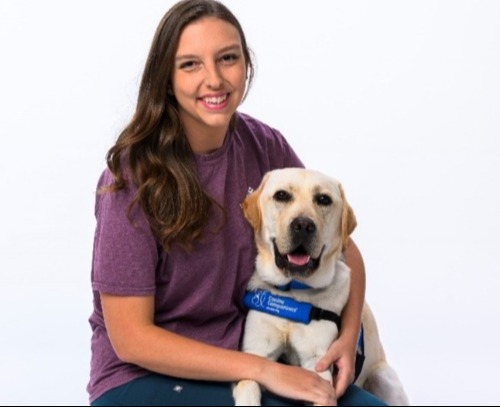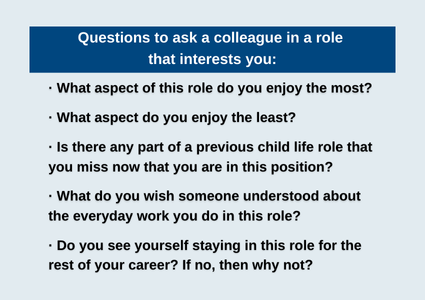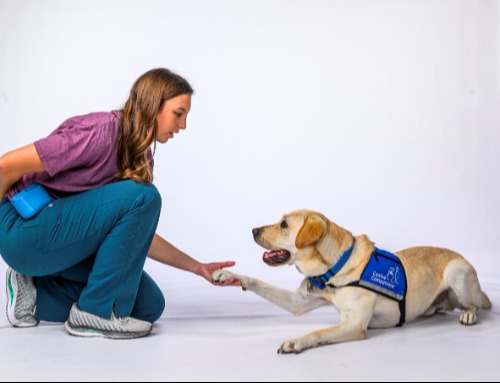
Author:
Shelby Strauser, MA, CCLS began her child life career in 2019 as a CCLS in the Emergency Center at Texas Children’s Hospital in Houston, TX. After 4 years of providing evening shift coverage, she accepted the role of Facility Dog Handler in the Acute Care population. Shelby was matched with Facility Dog Crosby IV in October of 2023, and together they serve patients on the neurology/neurosurgery, trauma surgery, and endocrine and primary hospital medicine units.

Just as people’s path to becoming a Certified Child Life Specialist (CCLS) is different, the same is often true for their career trajectory. Look at any established child life team across the country and there will be variety in the experiences of each specialist. The field of child life offers the unique ability to work the same role in a different setting, a tool specialists utilize for various reasons. Whether it be feelings of burnout, organizational differences or personal needs, the ability for a person to work as a CCLS on a different unit can prolong their child life career. After four years as a CCLS working nights in the Emergency Center, I began to long for new challenges in my professional life and consider the possibility of a change. Just as the 1981 hit from the punk rock band The Clash says, I realized it was time to ask myself “Should I Stay, or Should I Go?”
Deciding to Make a Move
Some might assume that it will be clear when change is necessary; however, more often individuals may report feelings of uncertainty. Personally, I found myself wondering, “What does it mean to know it is time for a change?” I questioned if there would be a specific patient interaction or intervention that would tell me it was time to move, or if there was a feeling of knowing it was time that I just had not experienced yet. Instead, it was the accumulation of emotions and circumstances over time that signaled a change was necessary. Through reflection, I realized it is more common that people experience multiple factors over time that leads them to a decision. These experiences could include having interest in a different population, wanting opportunities for professional growth, or having feelings of burnout and dissatisfaction within a current role.
Understanding that these factors exist is simple, but it is another to identify them in yourself and your work. In my experience, I related to the desire for professional growth. I found myself feeling as if I had “mastered” my role in the Emergency Center, and novel patient interactions became rare. Not encountering new challenges often led to a complacency that decreased my drive to seek out patient interventions. I remember feeling as if each shift was a repeat of the last, which then allowed feelings of dissatisfaction to creep in. That being said, having these kinds of thoughts once or twice after rough days should not always prompt further action. “One-offs” and hard days are normal for anyone, even those who are in positions where they truly believe they belong. It is when someone experiences these feelings repeatedly or with increased intensity over a longer period of time, and they are not resolved by other small changes, that a bigger change should be considered. Personally, as these emotions continued to present themselves over a period of 3-4 months, I knew it was time for a deeper reflection on what I could do to prolong my career as a CCLS.

Like any other major decision, choosing to change positions within the child life field must come with careful consideration. While the scope of the job and the role within the professional team stays the same from outpatient clinics to the pediatric intensive care unit, many other aspects will differ. Some of the more obvious changes include a difference in pay, hours, teammates or team dynamic, leadership structure and responsibilities. This information is vital as it all affects a person’s day-to-day life at work and at home. Beyond those changes, a person should also seek to understand how this new role could increase their fulfillment, satisfaction and passion. When I was considering the move to an Acute Care CCLS/facility dog handler role, my first action was to connect with those currently holding that position to hear their own description of the day-to-day work. I came prepared with questions and engaged in thoughtful conversations with these individuals. By speaking with my teammates, I was able to gain a better understanding of what the new role entails and make an informed decision about moving forward.

Challenges of Moving Roles
Excitement, relief and joy were all emotions I expected after officially accepting a new position but guilt, doubt and fear were not. I felt guilty for my Emergency Center child life co-workers, who would have to cover my position until it was filled by a new hire. I doubted myself nearly immediately, questioned my decision, and wondered if I would regret it. I know now that I am not alone in feelings this way. As a CCLS, I am used to being thee one to relieve feelings of distress in others, but in these moments, I felt as though my decisions may cause distress others. Being a “helping professional” comes with the never-ending internal struggle to remember it is okay to put one’s own needs above the needs of others.
Most people acknowledge that learning a new role requires time and effort, but many may be quick to forget how it also requires grace and patience. No matter if this is a person’s first time changing roles or their fifth, expecting excellence on day one is simply not reasonable. Unrealistic expectations are most often set by the individual, and the best tools to combat these expectations are patience and understanding. In the moments where doubt creeps in and finding grace for oneself difficult, the next best option is to receive it from others.
A strong support system is also crucial in navigating a professional role transition. As I was gaining independence in my new role and struggling to balance my own expectations, I found myself overwhelmed and emotional. After communicating this with my teammates, I realized that what I needed was someone to tell me that even though I made the decision to change positions, I could still embrace the difficult emotions I was experiencing as a result. This lesson continued to carry me throughout my transition, and it is one of the driving factors for sharing my experiences with others.
The emotions and overwhelming moments that come from changing positions are fleeting, quickly replaced by new opportunities and experiences. When I changed roles, I experienced a huge life change. I was now the proud owner of a new dog named Crosby! Crosby’s presence both in my role at work and in my personal life has brought joy and happiness I could never have fathomed beforehand. Other experiences may not come with as tangible (or furry) of gifts, but they are valuable just the same. Some will find themselves with the gift of time, when a new position comes with shift hours that will better serve a lifestyle or family needs. Others may receive the gift of money, if the new position includes a salary increase or new financial opportunities. Many find themselves with the gift of newfound passion for their new population or unit, and new personal goals and growth that increases their job satisfaction. These changes often provide the validation a person needs to know they made the right choice, even in the face of prior uncertainty and doubt.
A CCLS’s impact on the lives of patients and families is not limited by the unit where they work, the amount of experience they have, or the number of positions they have held previously. What can diminish their influence are feelings of burn out, doubt, regret or stagnation. These emotions can leave someone without the desire to go to work each day and perform successful child life interventions. Recognizing the signs that change could be beneficial will take self-reflection and awareness but can be the beginning of a happier and more fulfilling period of a child life career.
My hope is that any person who is considering a change, in the midst of a change or starting a new role will find support from my experiences. Those who devote themselves to continued growth and sustained passion make the field of child life better. For some, this looks like making the brave decision for change in the face of uncertainty. Still, this decision can lead to new opportunities and experiences, or in my case, a new paw to hold!

